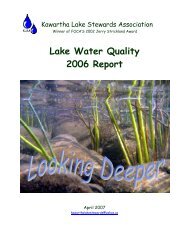Phosphorus and the Kawartha Lakes - Lakefield Herald
Phosphorus and the Kawartha Lakes - Lakefield Herald
Phosphorus and the Kawartha Lakes - Lakefield Herald
You also want an ePaper? Increase the reach of your titles
YUMPU automatically turns print PDFs into web optimized ePapers that Google loves.
mobilization process can be quite complex, but in its simplest form insoluble phosphorus<br />
can be reduced to a soluble state at <strong>the</strong> sediment-water interface through decreasing redox<br />
potential <strong>and</strong> pH levels. These conditions exist when lake sediment oxygen levels<br />
decrease <strong>and</strong> become anoxic (depleted of oxygen). This anoxic condition occurs in lakes<br />
when algae die <strong>and</strong> fall to <strong>the</strong> lake bottom. As <strong>the</strong> dead algae are decomposed bacteria<br />
consume oxygen <strong>and</strong> favourable conditions for phosphorus mobilization occur (Mackie,<br />
2001). Thus, once a lake becomes eutrophic (turbid algal state) this negative feedback<br />
loop can make restoration efforts challenging.<br />
So what does this tell us? It is possible to limit anthropogenic sources of<br />
phosphorus, creating an initial decrease in levels; however, long-term reduction may take<br />
many years as <strong>the</strong> insoluble phosphorus is mobilized <strong>and</strong> absorbed by plant species. The<br />
easiest way to restore a lake is to prevent it from becoming eutrophic in <strong>the</strong> first place.<br />
Recent studies suggest that <strong>the</strong> degree <strong>and</strong> rate at which a lake can reduce its phosphorus<br />
concentration depends on many factors; <strong>the</strong>se are discussed in <strong>the</strong> following section.<br />
Lake Recovery Potential<br />
The undesirable phenomenon of lake eutrophication has lead to many restoration<br />
efforts. Current research has been devoted to discovering <strong>the</strong> underling drivers in <strong>the</strong> reoligotrophication<br />
process. Søndergaard et al. (2005) conducted an excellent study of 12<br />
lakes in Denmark to determine lake response to reduced nutrient loads. Their findings<br />
demonstrate that internal loading of phosphorus can significantly delay lake recovery (up<br />
to 10 years) <strong>and</strong> that lake morphology (shallow vs. deep basins) must also be considered<br />
in restoration efforts. The shallow basins do not stratify (have one <strong>the</strong>rmal layer) <strong>and</strong> are<br />
subject to more wave action <strong>the</strong>reby altering phosphorus resuspension <strong>and</strong><br />
remobilization. A similar study by Jeppesen et al. (2005), which incorporated <strong>the</strong> same<br />
Danish lakes into a larger data set of 35 case studies, had similar conclusions concerning<br />
reduced nutrient loading. They found that internal loading delayed lake recovery; lower<br />
phosphorus levels did not stabilize until 10-15 years had past. Interestingly, fish biomass<br />
was found to decline in <strong>the</strong> majority of cases; however, piscivorous (fish that eat o<strong>the</strong>r<br />
fish) increased in 80% of <strong>the</strong> case studies. Phytoplankton community structure reverted<br />
back to oligotrophic species, but submerged macrophyte communities reappeared in only<br />
50% of <strong>the</strong> lakes for which data was available. As Declerck et al. (2005) point out,<br />
phosphorus can both directly <strong>and</strong> indirectly affect aquatic diversity. It can act directly on<br />
plants, which absorb it, or indirectly through changes in macrophyte communities<br />
creating habitat <strong>and</strong> refuge for fish <strong>and</strong> zooplankton.<br />
Two of <strong>the</strong> most important factors controlling lake response to reduced nutrient<br />
loads are mean depth (calculated as <strong>the</strong> lake volume divided by its surface area) <strong>and</strong><br />
macrophyte abundance (Genkai-Kato <strong>and</strong> Carpenter, 2005). Curiously, <strong>the</strong> lakes most<br />
resistant in recovering to a clear state are lakes of intermediate size. These problematic<br />
lakes have a mean depth around 10 meters. They are too deep to be aided by<br />
macrophytes (which decrease water turbidity by acting as nutrient traps, thus limiting <strong>the</strong><br />
resuspension of sediment material <strong>and</strong> negatively affecting algal growth (Portielje <strong>and</strong><br />
Rijsdijk, 2003)) <strong>and</strong> too shallow to mitigate internal phosphorus loading through dilution<br />
in <strong>the</strong> hypolimnion (Genkai-Kato <strong>and</strong> Carpenter, 2005). This suggests that some of <strong>the</strong><br />
2





